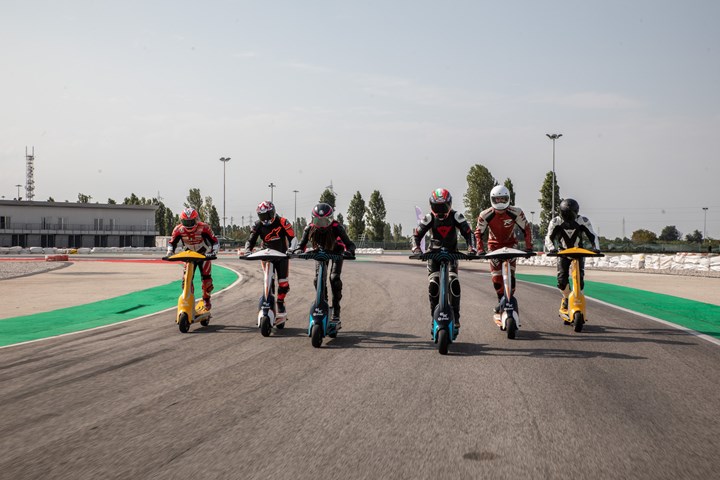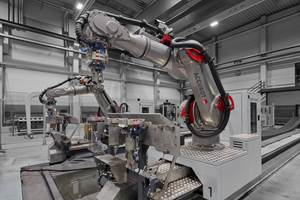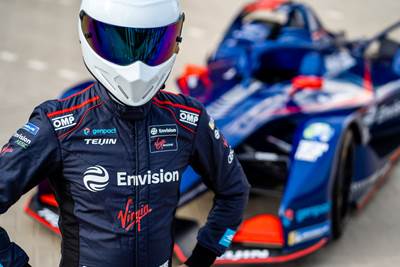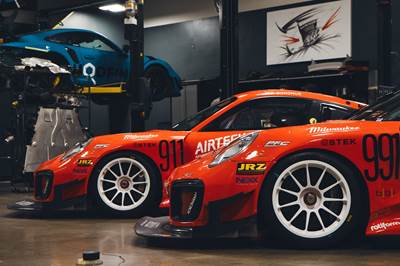YCOM composite all-electric race scooter adopted by eSkootr Championship
Italian advanced engineering firm completes first delivery of S1-X eSkootr less than five months after eSC partnership began, and acts as exclusive supplier for all race series competitors.
Share
Read Next

eSkootr Championship (eSC) racing series. Photo Credit, all images: YCOM
(Stradella, Lombardy, Italy), a company that specializes in motorsports engineering and lightweight composite design, has completed the official delivery and testing of its high-performance composite S1-X eSkootr for the eSkootr Championship (eSC), a new racing series that highlights e-mobility and frontier innovation. Supplied to all eSC competitors, the S1-X Skootr is YCOM’s first full-electric vehicle and can reach speeds of up to 100 kilometers per hour.
With expertise in designing and manufacturing technology for motorsport —including Formula 1 and FIA World Endurance Championship winners — as well as experience in the launch of multiple new race series, YCOM says it was well-positioned to develop, build and supply eSkootrs to the eSC. YCOM’s agile approach also enabled it to accelerate the S1-X’s development, taking the initial prototype to a production-ready design within less than four months. Not only that, but 10 race-ready eSkootrs have been delivered, YCOM notes, just five months after the partnership with eSC began.
Now, following YCOM’s rigorous twenty-day testing program, the capability of the S1-X has been successfully demonstrated. According to the company, analysis of telemetry has highlighted the reliability of the Skootr, with no major hardware or software issues found over the course of testing. The Skootr Control Unit (SCU), developed in-house, has been further refined for two-wheel-drive including five motor maps for both front and rear.
In a collective test with 16 different riders, the S1-X was initially limited to 40% power, increasing to 70% by the end of testing. Even at this output, YCOM says, many riders were fatigued by the physical demands of such speeds and lean angles of up to 55 degrees. With improved physical conditioning and additional practice in October testing, it is hoped that the riders will be able to use 100% power as well as the additional 20% temporary boost function in the first race.
“It has been fantastic to see the progress that YCOM has made since our partnership began. Their fast and flexible approach to engineering, development, prototyping and production has meant that we now have 10 S1-X Skootrs ready to race and have completed an extensive testing program,” says Hrag Sarkissian, eSkootr Championship co-founder and CEO. “Twenty more scooters will be ready in the few next months. I don’t think this would have been possible without YCOM. Its team’s ability to translate their knowledge, expertise and experience from other fast-paced motorsport development projects to a completely novel electric micromobility race vehicle highlights just how quickly they can adapt while maintaining an exceptional standard of engineering and production.”

Testing of the high-performance S1-X eSkootr.
Formed in 2020, the eSC is the world’s first micromobility racing series. Following exhibition events in 2021, its opening season in 2022 will see fierce racing between 30 competitors on specially designed circuits from 400 to 800 meters long. Intended to raise awareness of e-mobility and promote the rapid advancement of sustainable transportation solutions, the eSC marks a new chapter in motorsport history.
The S1-X Skootr will be standardized across all competitors in the eSC’s opening seasons to minimize entry costs and make the sport more accessible. As the series matures, competitors will have greater design freedom to modify and develop their own eSkootrs, with more open regulations to be introduced in 2023.
According to Nicola Scimeca, YCOM founder and CBDO, the e-mobility revolution is here. “We are thrilled to be involved in eSC and producing the S1-X for all competitors in the opening seasons. While they may appear vastly different on the surface, we applied what we had learned from our other high-performance electric vehicle programs, including Volkswagen’s I.D. R Pike’s Peak car,” Scimeca says. “Working alongside the eSC team to refine the design and match performance expectations within a limited timeframe has been challenging but well within our capabilities.”
He continues: “While it is rare that we can publicly discuss the projects that we are involved in, I am delighted that the S1-X can now be launched as our first official product. Developing innovative e-mobility solutions and promoting their adoption are two of the key drivers behind the eSC and we, as a company, have a strong focus on sustainability and forward-thinking projects. I am proud of our team and look forward to our ongoing and exciting technical partnership with the eSC.”
Related Content
ASCEND program completion: Transforming the U.K.'s high-rate composites manufacturing capability
GKN Aerospace, McLaren Automotive and U.K. partners chart the final chapter of the 4-year, £39.6 million ASCEND program, which accomplished significant progress in high-rate production, Industry 4.0 and sustainable composites manufacturing.
Read MoreTesting to support composite bolted joint analysis
An overview of ASTM Standard Guide D8509, and its coupon-level mechanical testing of design properties for analyzing composite bolted joints.
Read MoreAutomated robotic NDT enhances capabilities for composites
Kineco Kaman Composites India uses a bespoke Fill Accubot ultrasonic testing system to boost inspection efficiency and productivity.
Read MoreOptimized rib-reinforced hollow composites via printed molds
Addyx topology optimization and water-soluble mandrel enables simultaneous rib and skin layup for one-shot, high-strength, lightweight structures.
Read MoreRead Next
Teijin Aramid, OMP Racing composite Formula E racing suit raises the bar for protective performance
Ultra-light meta-aramid fiber garment maximizes both the safety and comfort of the Envision Virgin Racing Formula E team, harnessing flameproof, flexible and high-performance qualities.
Read MoreAirtech 3D-printed resins deliver composite tooling for competitive motorsport vehicles
BBi Autosport joins with Airtech Advanced Materials Group to develop high-performance carbon fiber body panels for its Porsche race cars using Dahltram resins and Print-Tech services.
Read MoreAll-recycled, needle-punched nonwoven CFRP slashes carbon footprint of Formula 2 seat
Dallara and Tenowo collaborate to produce a race-ready Formula 2 seat using recycled carbon fiber, reducing CO2 emissions by 97.5% compared to virgin materials.
Read More













